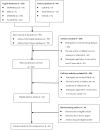An Update on Physical Activity Research among Children in Hong Kong: A Scoping Review
- PMID: 33212968
- PMCID: PMC7698465
- DOI: 10.3390/ijerph17228521
An Update on Physical Activity Research among Children in Hong Kong: A Scoping Review
Abstract
Similar to their Western counterparts, children in Hong Kong generally fail to reach the recommended levels of physical activity (PA). As an ultra-dense metropolis, Hong Kong is different from most Western cities. It is therefore important to update and appraise previous PA research in order to inform future PA promotion for Hong Kong children. Using a scoping review, the current study aimed to evaluate PA research among preschool and school-aged children in Hong Kong aged 3-12 years old who are at a critical development stage. Literature was searched from four English databases: Medline via EBSCOhost, SPORTDiscus, ERIC and PsycINFO via ProQuest; and three Chinese databases: CNKI, CQVIP and WAN-FANG. PA research among Hong Kong children published from 1 January 1997 to the searching date, 31 March 2020 was included. A total of 63 studies were identified, with the majority of studies focused on school-aged children as compared to preschoolers, adopted a cross-sectional design, using self-reported PA measures, and with small to medium sample sizes. We classified eligible studies into five main categories: (a) Health benefits of PA (k = 12). Consistent evidence on the health benefits of skeletal and cardiovascular capacity, quality of life, cognitive function, and sleep quality was revealed. However, inconsistent evidence was found on the benefits of weight-related indicators and academic performance. (b) Patterns of PA (k = 12). There is a general pattern of low levels of PA among Hong Kong children, in particular girls and children with special educational needs. (c) Measures of PA and related constructs (k = 11). The Chinese versions of self-reported measures of PA, PA-related social environment, and PA-related psychological constructs showed acceptable reliabilities and validities. (d) Correlates of PA (k = 18). The correlates of PA include physical environment, social environment, physical factors, psychological factors, and multiple correlates, which is in line with the social-ecological model. (e) Interventions for promoting PA (k = 10). PA interventions among Hong Kong children were conducted for healthy children, children with special educational needs, and children with cancer. Overall, there is a growing volume of PA research among children in Hong Kong in the recent decade. Yet, there is a lack of high-quality research for measuring, understanding, and promoting PA among Hong Kong children. It is highly recommended that future PA research among children should pay more attention on the preschoolers, adopting robust research design (e.g., randomized controlled trials), recruiting large and representative sample, and collecting device-assessed data.
Keywords: child; exercise; physical activity; research synthesis; review; youth.
Conflict of interest statement
The authors declare no conflict of interest.
References
-
- Aubert S., Barnes J.D., Abdeta C., Abi Nader P., Adeniyi A.F., Aguilar-Farias N., Tenesaca D.S.A., Bhawra J., Brazo-Sayavera J., Cardon G., et al. Global Matrix 3.0 Physical Activity Report Card Grades for Children and Youth: Results and Analysis From 49 Countries. J. Phys. Act. Health. 2018;15:251–273. doi: 10.1123/jpah.2018-0472. - DOI - PubMed
Publication types
MeSH terms
LinkOut - more resources
Full Text Sources
Medical
Research Materials


